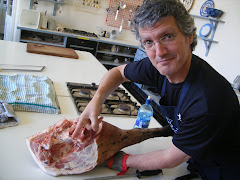
At Ballymaloe, a few other students and I had become quite interested in the sections of the course in which we learned about butchery. Whether it was pork, lamb, beef or game, it was very satisfying as we learned how to be economical in using all of the animal.
So when the chance to buy and butcher an organically-raised pig came round, clearly we jumped at it. Aside from miscommunication on the financial costs involved, it turned out to be one of my best days at Ballymaloe. Ten hours after collecting our two whole pig halves, literally head to tail, we had broken the pig down into spare ribs, chops, ham, pork belly, rashers, several cuts of roasts, loin, 11 kg of sausage and the cheeks which we cold smoked. We had several community dinners through which we barely made a dent to rid our freezers of a year's worth of pork. It remains the most flavorful pork I have ever eaten.
Nonetheless, it was such a brilliant experience that I have since obligated myself to buy a half pig with a friend and butcher it ourselves...all in a domestic kitchen. I'm quite certain that experience will find itself noted on this blog at some point. It also piqued my interest in the various processes of curing meat, specifically pork. Since returning to the States, I decided to become more aware of this process by going to Des Moines, Iowa and working a couple days at La Quercia. They are noted as the premier producers of American Prosciutto, supplying loads of top chefs and restaurants throughout the States.
The owners, Herb and Kathy Eckhouse, were great hosts as they allowed me to work with their staff for two days and learn a bit about curing pork. Obtaining their meat from suppliers who use humane methods, La Quercia follows a seasonal view of taking the pork through the various stages of salting, resting and drying. Albeit on a very basic level, I was able to get involved in several phases to include removing the salt and femur, trimming and washing the salt from the legs, and getting coppa readied for it's resting stage.
It's hard work with a lot of care and concern taken at every step. It's so easy for months of hard work to go pear-shaped with a lack of attention to detail. I certainly came away with a better understanding of the huge effort involved and how delicate a process it really is. For anyone working closely with food, I surely recommend getting stuck in and really finding out about where your food comes from and how it's produced. You can't help but appreciate what it takes to turn out not just decent food, but food that's considered to be the best.




No comments:
Post a Comment